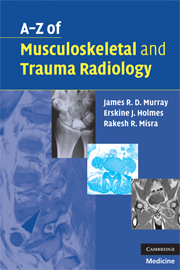Book contents
- Frontmatter
- Contents
- Acknowledgements
- Preface
- List of abbreviations
- Section I Musculoskeletal radiology
- Achilles tendonopathy/rupture
- Aneurysmal bone cysts
- Ankylosing spondylitis
- Avascular necrosis – osteonecrosis
- Femoral-head osteonecrosis
- Kienböck's disease
- Back pain – including spondylolisthesis/spondylolysis
- Bone cysts
- Bone infarcts (medullary)
- Charcot joint (neuropathic joint)
- Complex regional-pain syndrome
- Crystal deposition disorders
- Developmental dysplasia of the hip (DDH)
- Discitis and vertebral osteomyelitis
- Disc prolapse – PID – ‘slipped discs’ and sciatica
- Diffuse idiopathic skeletal hyperostosis (DISH)
- Dysplasia – developmental disorders
- Enthesopathy
- Gout
- Haemophilia
- Hyperparathyroidism
- Hypertrophic pulmonary osteoarthropathy
- Irritable hip/transient synovitis
- Juvenile idiopathic arthritis
- Langerhans-cell histiocytosis
- Lymphoma of bone
- Metastases to bone
- Multiple myeloma
- Myositis ossificans
- Non-accidental injury
- Osteoarthrosis – osteoarthritis
- Osteochondroses
- Osteomyelitis (acute)
- Osteoporosis
- Paget's disease
- Perthes disease
- Pigmented villonodular synovitis (PVNS)
- Psoriatic arthropathy
- Renal osteodystrophy (including osteomalacia)
- Rheumatoid arthritis
- Rickets
- Rotator-cuff disease
- Scoliosis
- Scheuermann's disease
- Septic arthritis – native and prosthetic joints
- Sickle-cell anaemia
- Slipped upper femoral epiphysis (SUFE)
- Tendinopathy – tendonitis
- Tuberculosis
- Tumours of bone (benign and malignant)
- Section II Trauma radiology
Osteoporosis
from Section I - Musculoskeletal radiology
Published online by Cambridge University Press: 22 August 2009
- Frontmatter
- Contents
- Acknowledgements
- Preface
- List of abbreviations
- Section I Musculoskeletal radiology
- Achilles tendonopathy/rupture
- Aneurysmal bone cysts
- Ankylosing spondylitis
- Avascular necrosis – osteonecrosis
- Femoral-head osteonecrosis
- Kienböck's disease
- Back pain – including spondylolisthesis/spondylolysis
- Bone cysts
- Bone infarcts (medullary)
- Charcot joint (neuropathic joint)
- Complex regional-pain syndrome
- Crystal deposition disorders
- Developmental dysplasia of the hip (DDH)
- Discitis and vertebral osteomyelitis
- Disc prolapse – PID – ‘slipped discs’ and sciatica
- Diffuse idiopathic skeletal hyperostosis (DISH)
- Dysplasia – developmental disorders
- Enthesopathy
- Gout
- Haemophilia
- Hyperparathyroidism
- Hypertrophic pulmonary osteoarthropathy
- Irritable hip/transient synovitis
- Juvenile idiopathic arthritis
- Langerhans-cell histiocytosis
- Lymphoma of bone
- Metastases to bone
- Multiple myeloma
- Myositis ossificans
- Non-accidental injury
- Osteoarthrosis – osteoarthritis
- Osteochondroses
- Osteomyelitis (acute)
- Osteoporosis
- Paget's disease
- Perthes disease
- Pigmented villonodular synovitis (PVNS)
- Psoriatic arthropathy
- Renal osteodystrophy (including osteomalacia)
- Rheumatoid arthritis
- Rickets
- Rotator-cuff disease
- Scoliosis
- Scheuermann's disease
- Septic arthritis – native and prosthetic joints
- Sickle-cell anaemia
- Slipped upper femoral epiphysis (SUFE)
- Tendinopathy – tendonitis
- Tuberculosis
- Tumours of bone (benign and malignant)
- Section II Trauma radiology
Summary
Characteristics
A systemic skeletal disease characterised by low bone mass and microarchitectural deterioration of bone tissue (Am. J. Med., 94 646–650 1993).
Increased bone fragility and susceptibility to fracture (Am. J. Med., 94 646–650 1993).
Pathology – increased resorption compared to formation of bone.
Post-menopausal women most affected.
Prevalence increases with age – but senile osteoporosis differs from post-menopausal osteoporosis, although this is not fully understood.
Racial differences likely to relate to higher starting bone density.
Family history may be positive.
Clinical features
Usually diagnosed secondary to a fracture.
Co-morbid medical conditions increase the likelihood of a fracture secondary to osteoporosis. For example, poor balance and falling sideways increases the risk of hip fracture six-fold compared to other directions.
Exclude eating disorders in the young patient.
Look for primary and secondary amenorrhoea, adequate calcium uptake and drug treatments, e.g. steroids.
Common fracture sites are the femoral neck, vertebrae and distal radius.
Vertebral fractures are often asymptomatic and discovered incidentally.
Kyphosis and loss of height can occur following vertebral crush fractures.
See Trauma section for clinical features.
Radiological features
Bone density is difficult to interpret on plain radiographs, hence the use of the term osteopaenia to describe the relative bony lucency.
See Trauma section for individual fractures.
DEXA (dual energy X-ray absorptiometry) is the current investigation of choice for the diagnosis of osteoporosis – measured as the standard deviation from the ‘normal’ range.
Management
Aimed at prevention, preventing progression and treating complications.
Prevention should begin early in life with education regarding good nutrition, weight-bearing exercise and limiting alcohol intake.
Fall prevention is useful in the elderly.
Group resistance exercise classes in athletic amenorrhoea are useful.
Supplementary calcium and vitamin D.
[…]
- Type
- Chapter
- Information
- A-Z of Musculoskeletal and Trauma Radiology , pp. 105 - 107Publisher: Cambridge University PressPrint publication year: 2008



